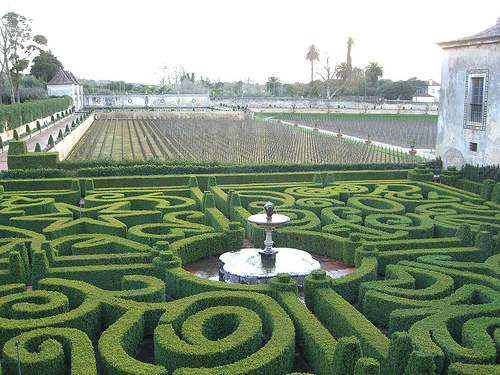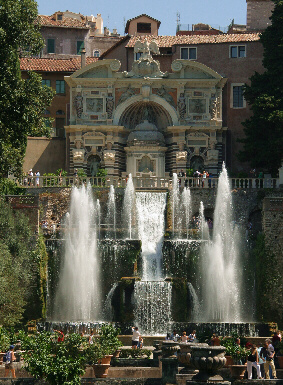Question: Explain with examples the ways in which the Renaissance spirit of a rediscovery of the classics and the new Humanist ways of thinking were expressed in the design and content of the Italian Renaissance garden.
In order to answer this question completely it is important to understand each component of the questions, i.e. what were Renaissance ideas and humanist ways of thinking?
The Renaissance, which formally began in Italy sometime during the early 1300s (Scholars still debate the actual starting date), was a refocus on classical Greek and Roman ideas. It was an age of discovery, invention and art. However, the new renaissance ideology was practiced by a very select segment of the population. Those who had enough money, time and cultural awareness had access to Renaissance ideas, but the vast majority of the population was not generally effected.
Humanism was a specific Renaissance idea that focused the attention of study on human importance in relation to God and nature, as opposed to the previous focus on divine and eternal matters. The study of man (broadly construed to mean humans) was a way to get closer to God. Since God had created everything in his image, studying humans and nature acted as a way to understand God.
These ideas translated into new garden designs and ornamentation. One way to see the influence of the Renaissance and Humanism is to examine the evolution of the quadripartite design. In medieval and monastic gardens, the beds were simply arranged with a few plants, a small water feature and a tree or two and each item in the garden had its own significance (tree - tree of life, water feature - rivers that flowed out of eden, etc.). However, when this is compared to a Renaissance equivalent, the designs of the interior sections of the bed become much more complex and ornamental. While each section of the quadripartite design did not have the same significance of the monastic garden, the overall theme was humanist. Nature was seen as an ordered creation of God, thus, man could organize and improve nature’s raw materials, and by doing so come to know God. The focus is on the human ability to organize and subject nature to man. Another example of this idea can be seen through the incredible water features that play a central role in many Renaissance gardens. For example, the Villa d’Este featured several water features that control and demonstrate the power of human innovation.
 Aside from the artistic recreation and innovation of the Renaissance, power relations played a dominant force throughout this time period. Gardens, as they have almost always been (at least partly), were a way to show off power and wealth. However, these new gardens were outwardly positioned. That is, they displayed ancient greek and roman epics and myths, which would often correspond to family history or lore. Educated visitors to the gardens would instantly recognize and understand the references. To take the example above of the Villa d’Este, one of the largest water features is the Dragon Fountain. This fountain was an allegory to the story of Hercules. It was said that there was a golden apple guarded by a ferocious dragon. Hercules defeated this dragon and took the golden apple. The d’Este family is coincidently said to be related to Hercules. These sorts of allegories were common in early Italian Renaissance Gardens.
Aside from the artistic recreation and innovation of the Renaissance, power relations played a dominant force throughout this time period. Gardens, as they have almost always been (at least partly), were a way to show off power and wealth. However, these new gardens were outwardly positioned. That is, they displayed ancient greek and roman epics and myths, which would often correspond to family history or lore. Educated visitors to the gardens would instantly recognize and understand the references. To take the example above of the Villa d’Este, one of the largest water features is the Dragon Fountain. This fountain was an allegory to the story of Hercules. It was said that there was a golden apple guarded by a ferocious dragon. Hercules defeated this dragon and took the golden apple. The d’Este family is coincidently said to be related to Hercules. These sorts of allegories were common in early Italian Renaissance Gardens.
Overall, Renaissance gardens transformed in size and complexity. The focus on man’s abilities and values helped fuel this transition and renaissance innovations in science, art and technology made it possible for gardens like the Villa d’este and Villa Medici come to fruition.
For more information on Renaissance gardens and their humanist influences check out some of these websites:
http://www.arthistoryspot.com/2010/02/renaissance-gardens/
http://www.casasantapia.com/images/gardens/italianrenaissancegarden.htm
http://en.wikipedia.org/wiki/Italian_Renaissance_garden
Sources:
http://blog.metmuseum.org/cloistersgardens/wp-content/uploads/2009/04/cuxa-lawn.jpg
http://www.gardenvisit.com/assets/madge/quinta_di_bacalhoa/600x/quinta_di_bacalhoa_600x.jpg
https://blogger.googleusercontent.com/img/b/R29vZ2xl/AVvXsEg0I1yBdadf1L7IgawwwKCAduR8-ooIzyfFG3sqlGvdvQDZGrIDv8ybec-p5-BMMzGKw732OpzoKyzTqX84trl7STFdlESEUec-StyjyIcryE7K0dGfr6EBUGuTI0gJ6sZCTTLLnD-xiVM/s1600/Villandry+2007+025.jpg
upload.wikimedia.org/wikipedia/commons/2/2f/One.hundred.fountain.at.villa.d'este.arp.jpg
http://blog.lib.umn.edu/schue141/matt_machete/DSCN3908.JPG
http://www.romanhomes.com/your_roman_vacation/tivoli-images/Tivoli-Neptune-fountain-m2.jpg




I really enjoyed your explanation of humanism in the quadripartite design. It's very interesting to look at its evolution from the monastic garden and its exemplification of, as you say, "nature...as an ordered creation of God."
ReplyDeleteHumanism during this time period seems to be used as a rationalization for conspicuous consumption. However off-puting the motives are behind humanism, its influence helped forge a new style in landscape and garden design.
ReplyDeletewhat are the off-putting motives behind Renaissance Humanism? If it hadn't happened we wouldn't be where we are today!
ReplyDeleteBy off-putting I mean more de facto humanism, that is, when Cardinal d'Este began building his gardens it is hard to believe humanist ideals were sought after from a place of pure motives. While he may have wanted to get closer to God or understand the relationship between nature and God more closely, he had clear priorities that differ from those of humanism. For example, he wanted the papacy for himself, he must have wanted to show off (the enormous water features) and he wanted to chronicle his families power, wealth and history. I suggest that humanism was a justification/rationalization to spend obscene amounts of money in an attempt to perhaps attain "improper" (improper if the goal is humanism) goals. The fact that the true ideological basis of humanism was in a sense weakened through improper motives is what is off-putting to me about humanism. Of course, the above could be said for (unsubstantiated) almost all doctrines and ideologies. To me, what is striking about humanism is the blatant use of money in relation to God: "Let's build a grand garden so we can understand and get closer to God."
ReplyDeleteI believe that life is a shared experience.
ReplyDeleteOften people are experiencing pain and disease as a result of living within a self-created (or rather self-accepted) box. A box that has been established by default over generations and never challenged or even seen for what it is. They believe that this box is the be all and end all of their life…their possibility for happiness. But in actuality, the box is the exact opposite. coaching for success
I like the efforts you have put in this, regards for all the great articles . vinyl wrap for furniture
ReplyDelete